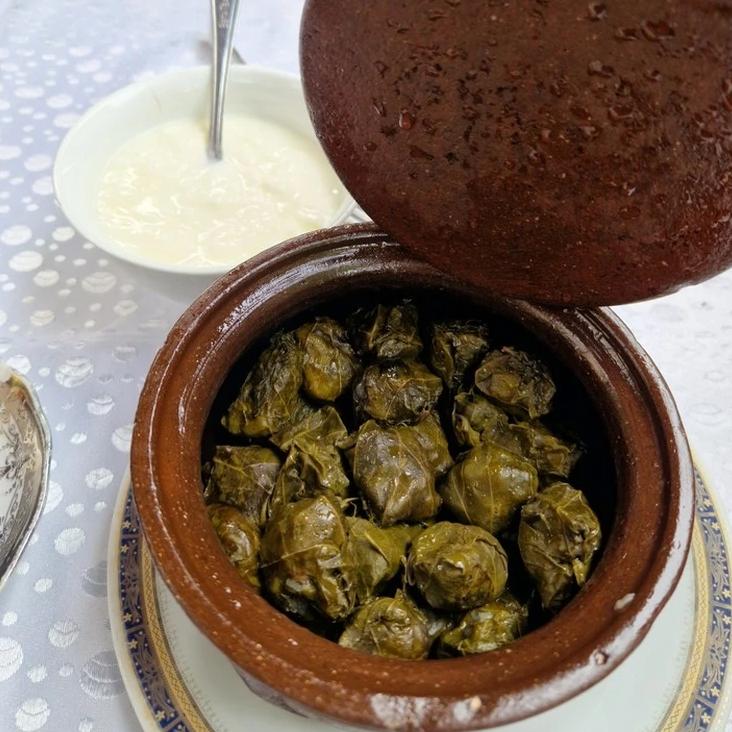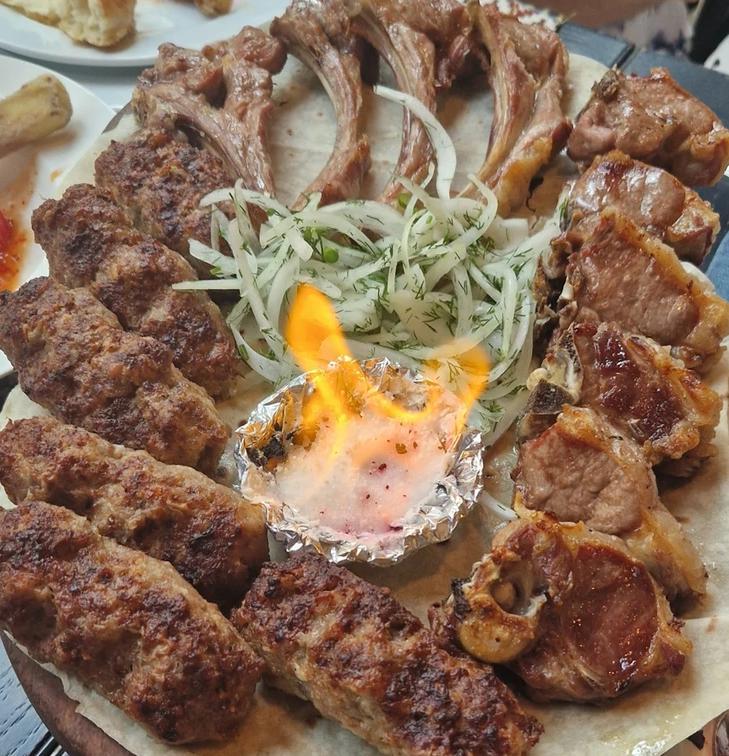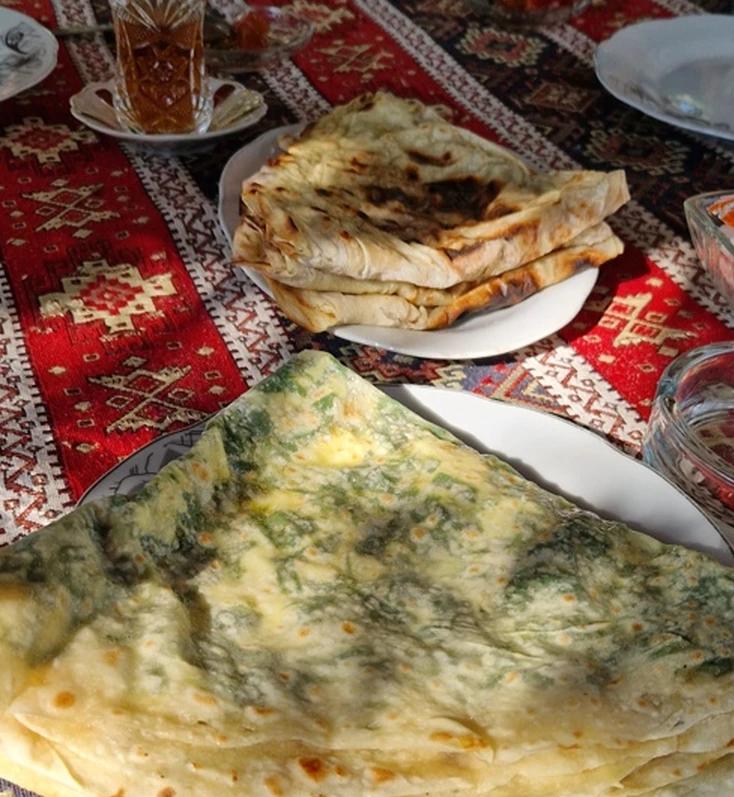Azerbaijan: Beautiful, rich, with abundant culinary delights "Komsomolskaya Pravda's" gourmet tour to the Land of Fire
The Russian newspaper "Komsomolskaya Pravda" has published a report about a trip of its female member to Azerbaijan. Caliber.Az presents the translation of the piece.
The New Year festivities are now behind us, prompting thoughts of planning for the upcoming May and summer holidays. Consider embarking on a culinary adventure to the Caucasus, perhaps to Azerbaijan. A delectable vacation is assured—I can attest to it personally. Five days in this splendid destination will pass by in the blink of an eye.
Day one. Railway stations, bazaars and breakfast turning into lunch
Familiarisation with the country began at the Heydar Aliyev International Airport. Baku struck me at once. The combination of antiquity and modernity. The scale and attention to detail. Unique appearance and at the same time unified facade of streets on which we travelled from the airport to the hotel, which instantly gave us a feeling of triumphal entry into the city and the old Land of Lights, as Azerbaijan is translated. And how many more impressions awaited!
I started my acquaintance with the country at the Heydar Aliyev International Airport. Baku impressed me immediately. The blend of ancient and contemporary elements. The magnitude and meticulousness. Utterly distinct visage and simultaneously cohesive frontage of streets along our journey from the airport to the hotel, promptly conveying a sense of triumphant arrival in the city and the historic Land of Lights, as Azerbaijan is translated. And numerous additional impressions were yet to unfold!
On this gastrotour, I promised myself to eat and drink everything on offer - otherwise it would be pointless to embark on such a journey.
So, at ten in the morning, I was treated to a traditional national breakfast at one of the city's most authentic restaurants: a variety of aged white cheeses, mountain honey, freshly baked hot bread from a clay tandoor, and robust black tea handpicked from the plantations of Astara and Lankaran. To say it was delicious would be an understatement—it was not only tasty but also quite nourishing. Surprisingly, it was considered a "light" breakfast, marking just the beginning of the culinary adventure. Grateful for the stroll around Old Baku between gastronomic point A and point B.
We traversed the primary, Double Gates, and found ourselves in a realm where the principles of our forebears still hold sway and time-honoured traditions are revered. Here, upon the main square, atop weathered stones, commerce thrives. The locals maintain that Baku assumed the role of capital relatively recently, specifically in the 12th century. This transition occurred following an earthquake that ravaged the heart of Shirvan, the city of Shamakhi—of which Pushkin once wove a romantic fairy tale about its ruler. The economic and cultural hub then shifted to Baku. It was during this era that the grand palace of the Shirvanshahs took shape, offering a vantage point from which one can now behold the entire expanse of the sea bay.
Kichik Gala Street winds its way to the enigmatic Maiden Tower, a subject of numerous legends. One indisputable fact is that it has transformed into a symbol of Baku. From this vantage point, the entire city unfolds as if held in the palm of your hand. Observing the small houses, steeped in the history of many generations, peering into courtyards, and inhaling the tempting aromas of dinners being prepared is an immersive experience.
Lunch in the Old Town unfolds like a cherished ritual. Azerbaijanis, known for their hospitality, have upheld the tradition of laying out an abundance from their homes on the table since time immemorial. The meal commences and concludes with tea, a deliberate gesture to convey the guest's cherished presence. Arrayed on the table are initial offerings: cheese, fresh vegetables, and dairy products. In Azerbaijan, the notion of salads or sauces is absent, emphasizing the freshness and inherent flavours of the ingredients.
As the capital, Baku reflects a harmonious blend of diverse traditions from across the country, while maintaining its unique culinary identity. Exclusive to Baku is the dolma crafted from the white grape variety Shany, exclusive to the Absheron Peninsula, and intricately rolled in grape leaves—a culinary art recognized by UNESCO. Served in a deep plate, dolma boasts a shimmering saffron broth at the base, with katyk, a garlic and salt-infused fermented milk akin to curdled milk, delicately placed on top. This combination allows the flavours of the dish to unfold harmoniously.

When I saw this gastronomic splendour - also lavishly served - the memory of a hearty breakfast faded away. I had no idea that my puny body could hold so much. Truly, one never fully comprehends their capabilities until faced with unexpected indulgences…
Following that, we strolled through the local bazaars, where an abundance of stalls showcased the rich bounty of Azerbaijan's fertile soil. With nine out of the world's 11 climatic zones present in the country, even tropical fruits flourish on this land. Browsing through the markets, it's customary to sample before making a purchase, and haggling is an unwavering tradition. Tea merchants entice with infusions promising male strength, female beauty, improved mood, and enhanced character—a perhaps contributing factor to the locals' mutual friendliness.
Dried fruits glistened in the sun, resembling a scattering of precious stones, while the fresh fruits beckoned with their enticing aromas and firm textures. Luckily, hunger wasn't an issue, as I remained satiated until day's end. Before retiring for the night, I embarked on a special stroll through the National Park affectionately known as Baku Boulevard. A leisurely walk along the seashore allowed me to relish the sea air and savour the tranquil ambience.
On this particular day, we embarked on a journey to the most enigmatic corner of Baku, nestled in the northern outskirts of the Absheron Peninsula. Here, Yanardagh has been ablaze and erupting in flames for centuries, transforming a small hill into a captivating spectacle where self-igniting methane creates the illusion of a gateway to the underworld. Perhaps inspired by the notion of rebirth prevalent in the area, local residents crafted a dish that symbolizes life itself - halva made from sprouted wheat. Each family guards its unique preparation secrets and distinct spice blends. The significance of this halva, derived from wheat sprouts and requiring a meticulous six-day preparation process, resonates deeply with the descendants who once believed in the possibility of cultivating amber figs even in the arid soil of Absheron.
Following a mystical halva breakfast, we ventured to another bastion of eternal life - the Ateshgah temple of fire worshipers. In Azerbaijan, there exists a profound reverence for fire, a sentiment that has endured for millennia. The allure of oil and gas emerging from the earth has captivated the imagination of all who have encountered the legendary "land of eternal flame." It is, therefore, fitting that in this very place, the religion of Zoroastrianism, centered around the worship of fire, originated. Here, the mastery of taming fire is evident, skillfully transforming it into life-giving embers for the preparation of succulent kebabs.

Today for lunch I try only 6 of the 180 types of kebab that are available in the country. A masterful chef can not only skewer meat without it falling off, but also give it amazing shape and flavour by adding a magical blend of secret ingredients. The meal begins with a type of meat, which is cooked and served on a stone, and ends with an appetizer of fruits baked on the grill with spices. And all this abundance is always accompanied by tea with one of 300 types of jam.
Day Three. Silk Road, Shor (a type cottage cheese) and Gutabs
The Silk Road and the mirror road guide travellers to the northwest of the country, unveiling the picturesque emerald-green city of Sheki.
En route, we made a breakfast pitstop in the town of Shamakha, renowned for its inhabitants' mastery of over 100 techniques for crafting “shor”. Azerbaijan, blessed with abundant salt mines and the Caspian Sea, has never faced shortages, even facilitating its export along with the Silk Road through the country. After savouring village butter derived from buffalo milk and relishing the local shor, our next destination is the Juma Mosque, hailed as the second oldest mosque in the Caucasus.
The journey over the mountain pass from Shamakhi takes approximately two hours. Upon reaching the lush forests of Ismailly, we paused for lunch at one of the many roadside cafes. Every 100 meters, vibrant local cooks, often housewives, skillfully prepared gutabs - thin flatbreads crafted from yeast-free dough and generously stuffed with herbs, meat, cheese, pumpkin, chestnuts, or tripe. Consumed exclusively by hand, kutabs are first sprinkled with sumac and then rolled into a tube. To enhance juiciness, the gutabs are generously coated with melted butter, and a delightful touch of sour cherry plum sauce is added inside. For good digestion, it is customary to accompany gutabs with freshly squeezed pomegranate juice or pomegranate wine.
The sight of pomegranate wine in a glass under the sun captivated me with its rich dark garnet colour. The taste was delightfully tart, almost viscous, velvety, offering hints of spices, berries, and prunes. The second glass contained a sweeter variation. Renowned for retaining the beneficial properties of pomegranate, the wine is believed to boost immunity through its rich content of vitamins C, P, B6, B12, and tannins. In a word, I treated myself to a delightful experience while simultaneously improving my health.

Arriving in Sheki quite late, we promptly checked in, and exhaustion led us straight to bed. Rest was essential to ensure we had the energy to fully immerse ourselves in the delights of this capital of sweets and wine the following day.
Day Four. Sheki - city of sweets and wine
Sheki stands out as a unique region, boasting its distinctive cuisine, language, and traditions. To fully savour the vibrant tapestry of local life, we ventured up to the nearby village of Kish. Here, a monument to Azerbaijan's Christian past unfolds in the form of one of the oldest churches dating back to the I-V centuries, now accessible to all as a museum. In this setting, local hostesses have ingeniously celebrated the abundance of walnuts. For breakfast, they invited us to relish sweet pilaf adorned with crushed walnuts, paired with layered walnut bread, and complemented by tea infused with walnut jam. According to the residents of Sheki not allergic to nuts, this breakfast was hailed as the best of all. I, however, nearly succumbed to the exquisite temptation of delightful overeating.
Following breakfast, we made our way back to the historical centre of Sheki. Within the 18th-century fortress, a UNESCO heritage site, we explored the Palace of Sheki khans. The structure resembles a jewellery box—unassuming on the exterior but adorned with vibrant decorations within. In Sheki, the traditional craft of wood and glasswork in the Shebeke style has been meticulously preserved. Skilled craftsmen in the area can intricately describe the process of creating a single square meter of window using a staggering 14,000 microscopic parts.
Sheki, nestled in the renowned Alazan Valley region, benefits from fertile soil and a favourable climate, allowing for the cultivation of not only nuts but also exceptional grape varieties, including the renowned "rkatsiteli." Harvested meticulously by hand, the grapes undergo a delicate pressing process to extract maximum flavour and aroma from the skin. To witness this firsthand, we visited the Sheki Sharab winery, where we could truly experience and savour the essence of the Earth through the local winery's products.
Interestingly, the Sheki Sharab winery is associated with the production of the once-legendary port wine "Aghdam," crafted from the same "rkatsiteli" grape variety. Although temporarily and undeservedly forgotten, it has now been revived under the guidance of experts from the Russian company "Abrau-Durso." Notably, the production of port wine exclusively utilizes grape distillate, not ordinary alcohol such as grain alcohol, which significantly influences the quality and flavour of the wine. Following fermentation and ageing in steel vats, the port wine matures in oak barrels of varying ages and volumes for more than four years.
I enjoyed the flavour; they offered me a taste, and it was sweet with hints of nuts, candied fruits, melon, and dried fruits. Interestingly, at the Korean Wine Challenge 2023, "Aghdam" from "Sheki Sharab" (Sheki Winery) won a silver medal and received high praise from the professional jury for the first time last year.
In 2021, Abrau-Durso acquired a winery in Sheki, and since then, the company has been actively advancing its operations. The cultivation of autochthonous grape varieties, namely "Madras" and "Bayanshira," is undergoing expansion. There is a comprehensive modernization of all phases of still and sparkling wine production, coupled with the inauguration of the region's inaugural wine museum, Az Abrau. The museum showcases the extensive history of viticulture and winemaking in Azerbaijan, offering a glimpse into the rich cultural heritage of the region.
Following our visit to the Az Abrau winery and museum, we proceed to a local restaurant for dinner, where we will learn the art of enjoying piti—a lamb soup cooked on coals in clay pots, following the authentic traditions of Sheki cuisine. The Sheki residents hold their culinary traditions dear, and they advise adhering to specific guidelines even in the consumption of their dishes. The proper way involves first sipping the broth, enhancing it with sumac for acidity and spice, then breaking the bread and finally mashing the meat and chickpeas into a puree, consuming the amalgamation as a second course.
Due to its exceptional density, piti is traditionally considered a dish for men. However, resilient local women are also eager to savour this culinary delight. For dessert, they often indulge in the famous Sheki halva, a unique creation crafted from rice flour and honey, adding a sweet and distinctive conclusion to the meal.
Day five. Let's cast a rod to come back
Not far from Baku, in a fishermen's village, a unique dish called lavangi from fish is prepared. The Caspian Sea, despite being classified as a lake, has a lower salt content than other seas, hosting distinctive fish species like kutum. When kutum is filled with a mixture of chopped nuts and onions and then grilled, it results in a dish typical of the southern parts of the country. Preparing lavangi requires careful attention to ensure that the nutty flavour doesn't overshadow the delicate taste of the fish, leading to the use of various spices. The dish is typically served with pomegranate sauce.
That concludes our culinary adventure, although the trail of wonderful memories from this beautiful, rich, and tastefully generous land will linger for many years. Should you desire, you can always return here for more delightful experiences.








